Bug of the Month: Taking a Deep Dive Into Stillwater Fly Fishing
Throughout this season, we will have blog entries that focus on different aspects of stillwater fly fishing. This month, we’re taking a deep dive into stillwater fishing — from techniques, to bugs, to gear. Our experts share their techniques for stillwater success, too. Jon Easdon, Kenny Romero, and Covey guides and retail team all contributed their expertise to this blog.
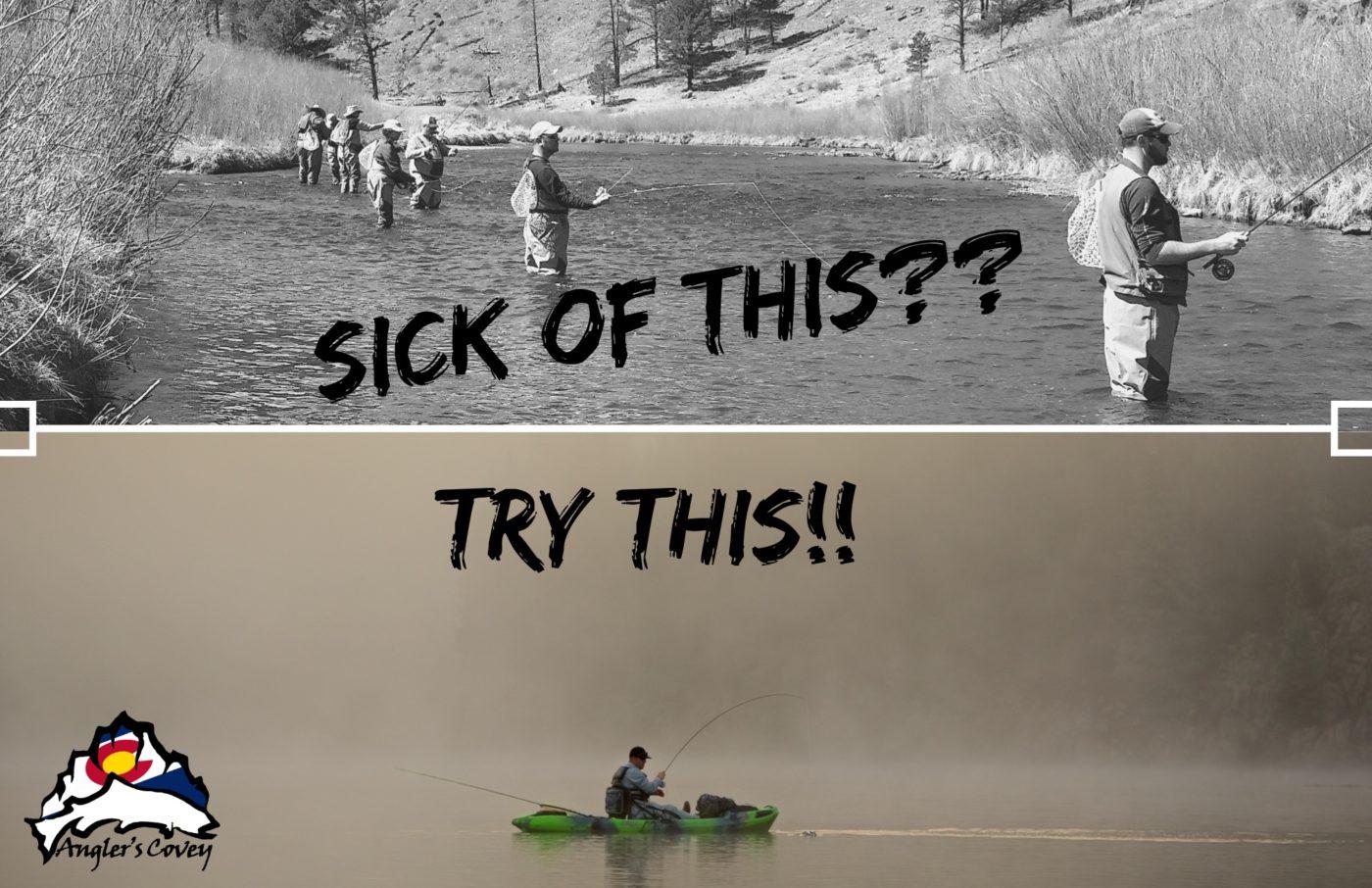
Although stillwater fly fishing can be one of the most thrilling ways to catch large trout in Colorado, many anglers overlook this fantastic opportunity in favor of rivers and streams. Maybe they believe that stillwater is too mysterious or boring. Or maybe some folks just aren’t aware of the great fishing available on our local ponds, lakes and reservoirs. And concerned about social distancing? No problem on our local stillwaters. Fantastic fly fishing is just waiting for you within a short one- or two-hour drive from Colorado Springs on the Pikes Peak water shed on reservoirs on the South Platte river drainage. So, for our Bug of the Month we are offering up some underappreciated adventures and waters: stillwater fly fishing..
As Kenny Romero, one of our guides, says, “you’re missing the boat (pun intended) if you’re not exploring stillwater fly fishing.” It will push you out of your comfort zone, for sure, but we know what that means: more risk, bigger reward.
Because of quality water and strong vegetation growth that produce an abundance of food sources, trout grow big in local reservoirs like Spinney Mountain and Elevenmile. Combine that with plenty of room for trout to spread out and spread their fins, and you have the recipe for healthy, big, and strong fish!
“Right at ice-off, the bite can be electric with cruising fish foraging for an easy meal. At this time, most of the trout are very close to the shore searching for food. This make fishing lakes very easy for any angler,” Easdon says.
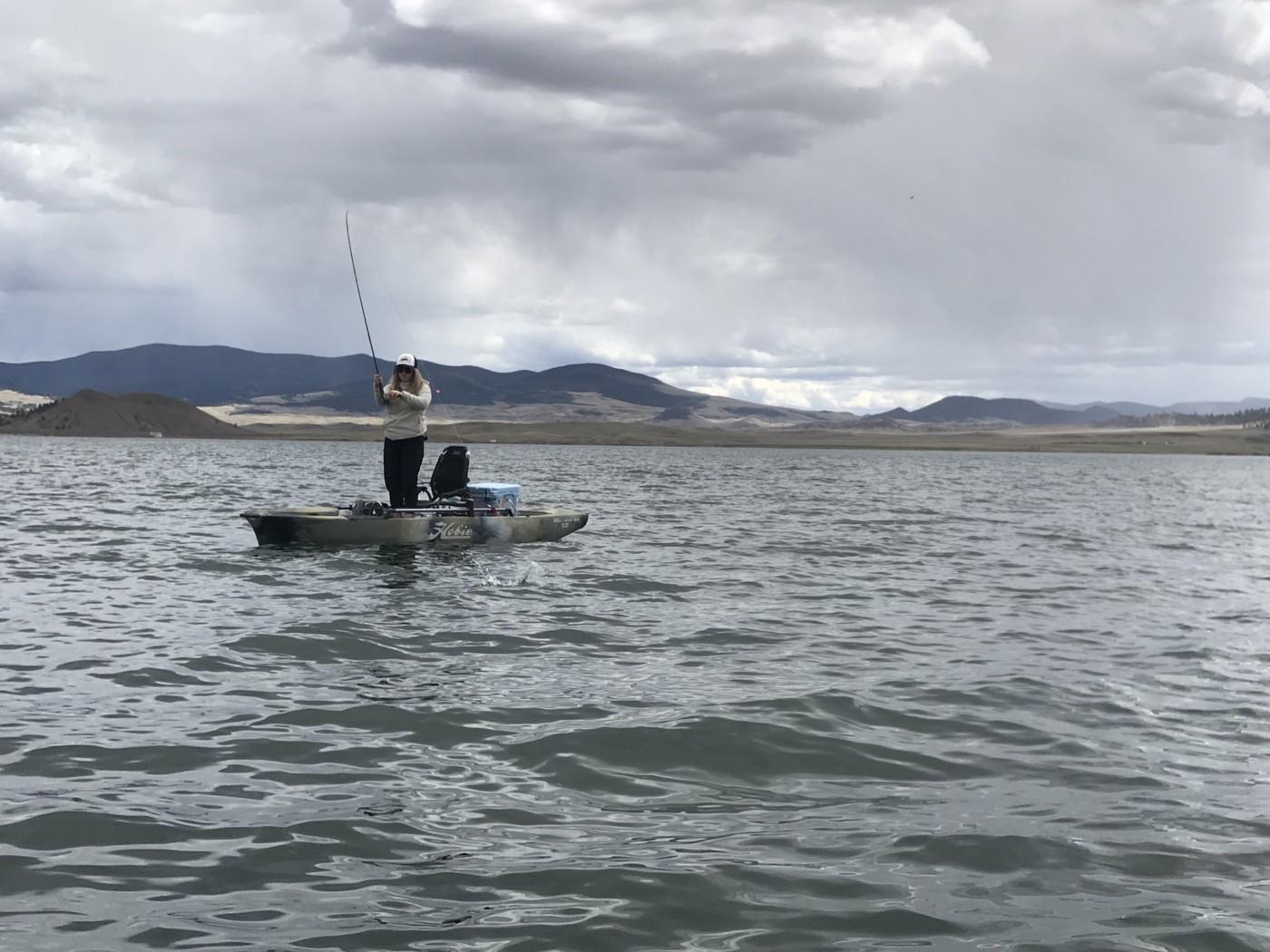
Techniques for Stillwater Fly Fishing
For Productive Days from the Shore
Tip 1: For being wind aware, you might not want to fish a shoreline where the wind is blowing straight into your face. Pick a shoreline with the wind at your back.
Tip 2: You’ll see fish cruising along the shoreline because they have to move to find the food – unlike their brothers in the river where the food is brought to them. Anglers will still want to get depth and length on their casts. Make adjustments to both as you cover more water.
Tip 3: Fishing from the shore, you do have to make long casts. If it is windy, you have to make pretty powerful casts. You could use a 5 wt but you have to work so much harder with less effect. You can have more fun casting a 6 or 7 wt rod over the course of the day. If I’m headed to Spinney, I’m taking a longer, heavier rod.
Tip 4: You’re going to see a lot of anglers head to our reservoirs when opening day is announced. There’ll be a lot of boats at Spinney because having the capability to access a lot of water is huge.
Tip #5: If you are fishing from the bank, it’s good to be able to access deep water with a long cast and long leader. This is also one of my favorite times of years to throw streamers. The trout’s metabolism is on the upswing, and streamers will fool big fish. It’s more exciting for me too. The eats are pretty visual, but even if you don’t see the take, it’s usually super aggressive.
Suspension fishing under an indicator or stripping these patterns can be equally effective methods. Justin Brenner recommends at least 4x tippet because South Park reservoirs can and often do give up fish of a lifetime. Easdon adds that he often changes to a 3x tippet and that, “suspending or slow stripping leeches, eggs, chironomids, and scuds will be the ticket. One important thing to keep in mind is that these fish are often traveling in pods. It’s very common to have breaks in between action as fish move through the lake.”
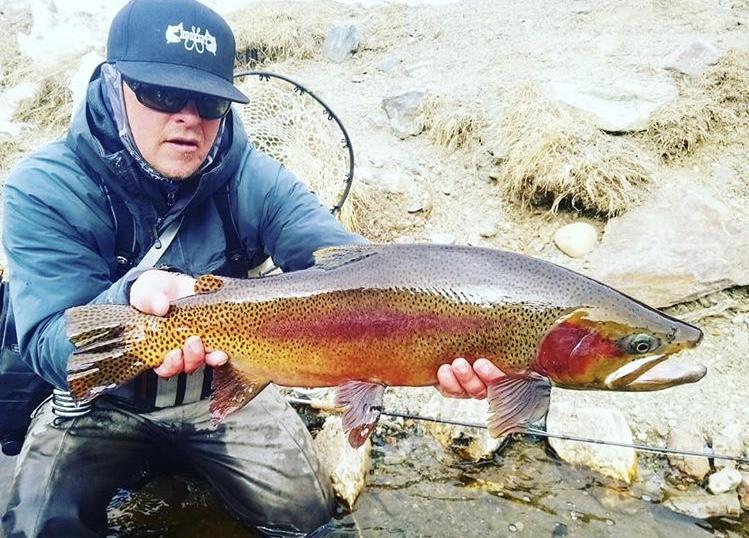
Fish don’t necessarily key “on certain hatches until water temperatures rise and plant life forms. Although present year round and the water warms into May, hatches of chironomids will become more prolific.”
Mobility can be a key factor when fishing any stillwater destination. A float tube, kayak, personal pontoon boat or motor boat will get you to where the fish are. During the early spring, fish are hugging the shorelines and mobility isn’t as critical. But come the end of May, most of the big cruisers have moved out into other parts of the lake. And wherever the weeds grow is where you’ll find fish. Don’t overlook the shallow flats either. Many large fish cruise these areas during a hatch looking for an easy caddis, callibaetis, or hopper meal. Dropping a callibaetis nymph behind a #10 Hopper Juan or Amy’s Ant is a good double threat as well.
Early Season Patterns
Especially in early season, from ice-off to later into the Spring, what patterns should be in the fly box?
The fly selection for our lakes and reservoirs is a lot like our fly selection for rivers, minus the stonefly. Don’t hesitate to use egg patterns and worms. Yes, steak and eggs.
Streamers are also a ton of fun in stillwater. Jon Easdon says, “this is where an angler can really get hooked on streamer fishing. If you are fishing for Pike, this is where your focus will be.” Kenny adds that wooly buggers and slump busters are also productive patterns early in the season.
Scuds are often overlooked and are often a preferred food source for trout. These aquatic invertebrates thrive in lakes with good substrate. You’ll oftentimes see trout rooting through weeds eating these, and they are effective year round.
Leeches are found in almost every body of water in the world. These make easy pickings for the trout, and they are definitely focused on them.
Snails are often plentiful in many reservoirs in the South Platte Basin. When fishing rockier areas, tying on a snail patterns always can be a great choice.
Kenny Romero, long-time Guide and stillwater expert, includes these patterns on his Top Ten list:
- Conehead Wooly Bugger
- Chironomid
- Callibaetis (Poxyback)
- Stillwater nymph
- Slump Buster
- Egg Pattern (peach, orange, and pink)
- Stimulators
- AP Muskrat
- Caddis Dry
- Damsel nymph and Bird’s Nest nymph
As water temperatures rise daily, fish become energized and hungry. “Woolly buggers and streamers are also very effective this time of year — as well as year round. And believe it or not, snails are a significant food source for Spinney Mountain large trout.” See what Kenny Romero carries in his stillwater flybox here.
Kenny adds that “the primary food sources in late May and early June in Spinney Mountain and Elevenmile reservoirs are chironomids, sucker eggs, and crawfish. Strike indicator rigs with these imitations fished at the right depth will produce fish.” By the end of May, most of the big cruisers have moved out into other parts of the lake. Mobility can be a key factor when fishing any stillwater destination. A float tube, kayak, personal pontoon boat or motor boat will get you to where the fish are. Brenner and Romero both say that in early summer hatches of calebaetis, damsel flies, and caddis start to emerge.
Bug of the Month: The Chironomid
Chironomids are the midges of the lakes. They are a go-to bug for the stillwater angler year-round, and they should be in your fly box for early ice-off fishing, for sure.
The Chironomid life cycle progresses through four cycles: egg, larva, pupal, and adult.At the larva stage, the insect may suspend just a few inches to a few feet off of the bottom of the lake as they emerge from tunnels burrowed in the mud. Because they are feeble and inefficient swimmers, an angler can do well to have slow retrieves, letting the imitation rise and fall. As they near the surface in the pupal stage, chironomids will draw fish up in the water column as they attempt to break through the surface of the lake.
When it comes to fishing the range of chironomid patterns, an angler has a couple of approaches. She can use a static nymph rig, suspending the imitations off of the bottom of the lake. With that technique, the waves and chop of the lake will cause the rising and falling motion of the larva. In another strategy, anglers can use a more active technique, “nymph stripping,” to imitate the bug’s feeble swimming. Unlike stripping with streamers, nymph stripping is more of a slow crawl, a steady retrieval with a longer pause to let the flies rise and fall. Chironomids in sizes 10-18, will make up the bulk of the bugs in lakes, and just like in the river, they will be a constant food source for the fish. According to Kenny Romero, Chironomids make up about ¾ of a trout’s diet.
Tying Up The Chironomid
For fly tyers, these are huge flies, tied on a longer shank hook. While they are relatively easy to tie, using a heavier gauge hook is important. Jon adds that “from a fly tyer’s perspective, a great advantage is that stillwater bugs are NOT small! Stillwater patterns are larger and a lot easier to tie than size 26 midges. It’s also better for those folks that struggle rigging the smaller patterns on light tippet.”
Tips for Stillwater Fly Fishing From a Watercraft
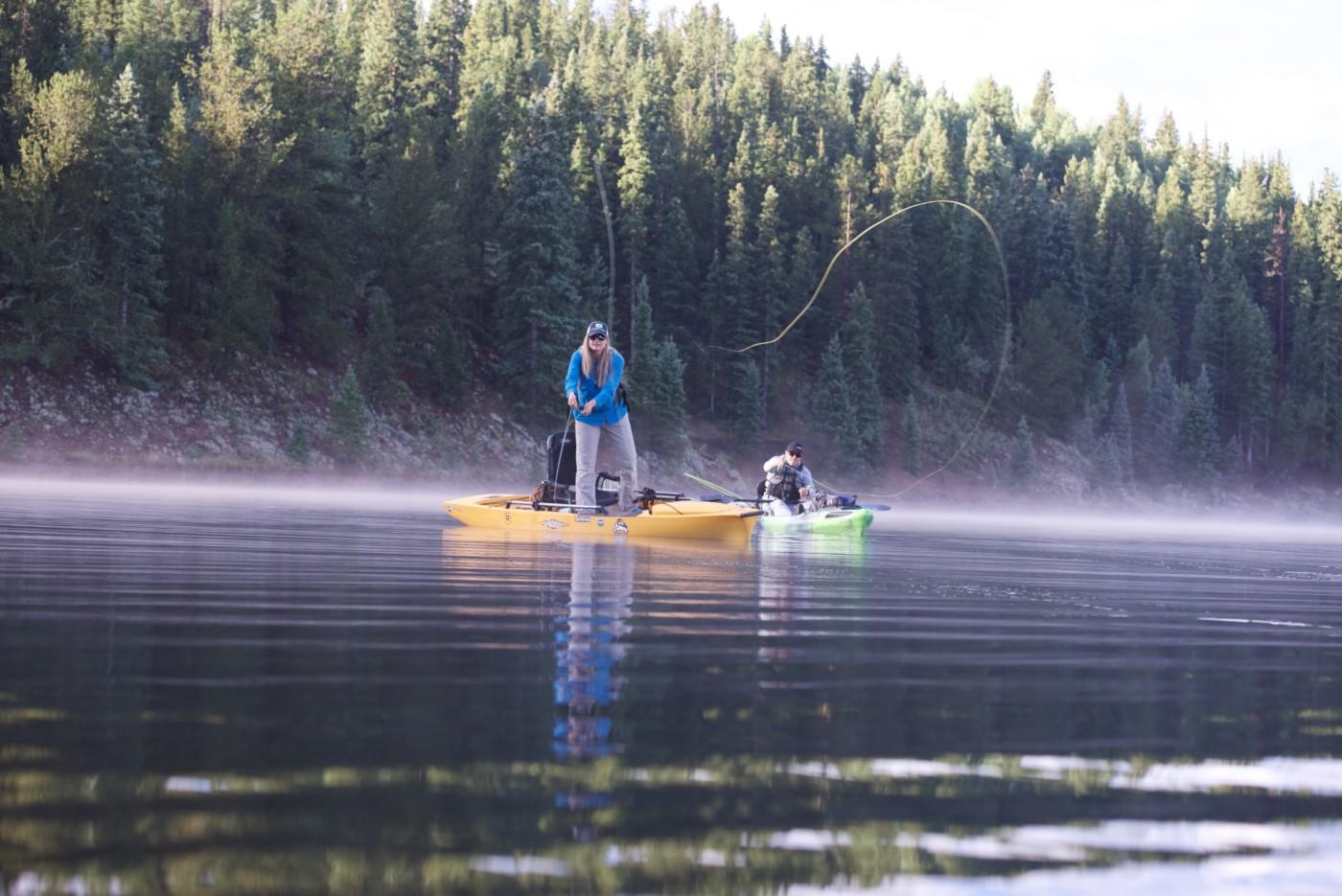
For fishing out of any watercraft, being “wind aware” is key. Where will the wind take you if it spikes up to 40 mph? Being on the wrong side of the lake when this happens can be brutal. Always think of your exit strategy.
No matter where you are fishing in a lake, depth is absolutely key. Fish will feed at certain depths and if you are not fishing those depths, you won’t even touch a fish. Play with your depth!
Use different fly connection knots. Explore the non-slip loop knot to give your flies more life under water.
Considering Stillwater Gear?
If an angler chooses to just use a 9′ 5 wt — what are advantages / disadvantages for stillwater fly fishing?
Jon Easdon, Director of Services, Guide says that, “While you can certainly use a standard 9′ 5 wt rod, it’s not ideal. It will get the job done, but there are much better options out there for stillwater.”
The only real advantage for using a standard 9′ 5 weight rod is that you don’t have to buy another set-up and you’re already used to casting that rod and reel. The big disadvantage is if you have a heavy nymph set up, or maybe you want to cast that set up further out, you will have difficulty casting a 5 weight line. It doesn’t have the weight to carry that effectively. Same with streamers, particularly if you are going to fish a sink tip line. It’s really tough to get that line out with a 5 weight. You could make the 9 ft 5 wt a dry fly rod for fishing dries on on Spinney, Elevenmile and Antero.
What if budget is a consideration?
The great thing about fly fishing, in general, these days is there are a lot of budget-minded products out. You don’t have to spend a ton of money to get a serviceable set up. In order of importance, spend the money on good fly lines, as they can make or break your set up. Second would be reels, and again focusing on a reel with a good sealed drag. Rod selection would be last.
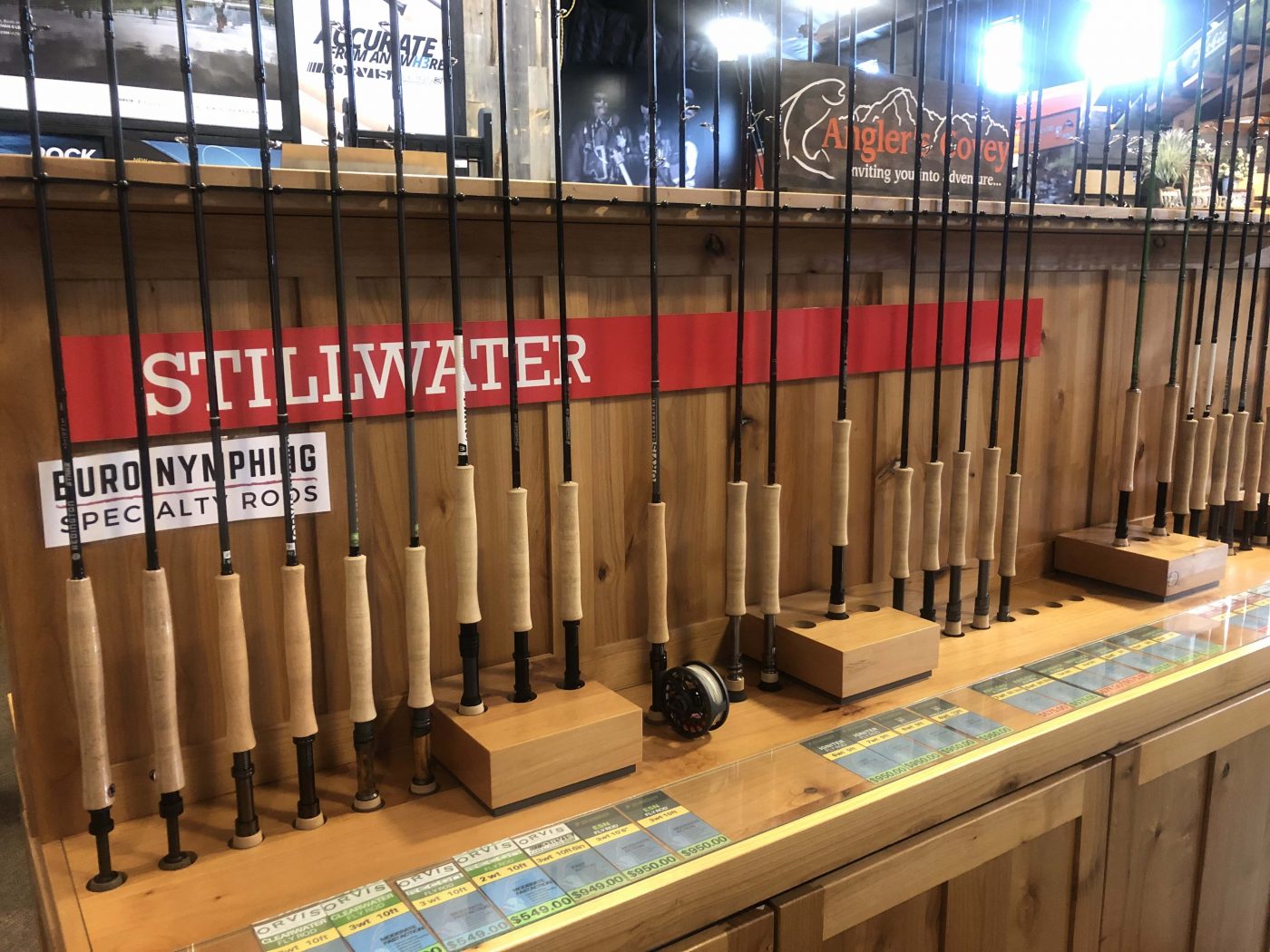
If an angler wants to set up a stillwater fly fishing combo specifically, what sorts of things should the angler consider? Let’s start with lines.
Fly lines can also get complex in this scenario too. If you want to keep it simple, A standard WF floating line will cover most bases. For me personally, Easdon has 3 different systems that he fishes on stillwater that require different fly lines.
First, with a standard WF floating line Ill use for my dry fly, dry/dropper, and static nymph rigs. I like heavier headed lines like power tapers or nymph specific lines. Again, these will help in casting and in turnover.
Second, “I like a type 1 intermediate sink line. This is a system that I have been using more and more for slow stripping or crawling nymphs and is my go to. These lines will drop your offering down around 2 feet below the surface. Which is in fact where the majority of fish like to feed.”
And lastly, Easdon chooses a type 2 or 3 sink lines for throwing big meaty streamers for trout and pike.These lines are heavy and get that fly down quick.
We also use way heavier terminal tackle like 0x-3x. You have to remember that fish in stillwater fight a lot different than their river run brothers and are not generally “tippet shy.” For toothy critters I will also use a wire leader or wire tippet.
What are some particular brands of lines to consider?
When it comes to lines, you’re going to be casting a bigger rig a longer distance and you need a line that is a little on the heavy side to help carry that. For fly lines to be effective in stillwater, the taper is heavier in the front. The Big Nasty is meant for big flies, for big indicator rigs and are meant to carry big bugs. Stillwater Floater is another. It has a different taper to really shoot that line out further. Especially, too, if wind is at play the extra weight will help you shoot that line out.
I like the Rio Stillwater Floaters. The longer heads help with turning over the heavier indicator rigs. If you’re fishing from the banks, in a lot of situations, you’re not going to have a lot of back cast room, so longer head lines will make that roll-cast just a little easier. Most are a pretty good shooting line, so if you have to cast far, these will do that – if you need to make some overhead false casts and then bomb some line out.
All of the guys agreed that budget, personal preferences, and type of fishing are factors. Come into the shop and discuss what line might be the best for your goals.
How about reels? What are the look-fors in selecting reels dedicated to stillwater fly fishing?
For the reel, most guides the like large or extra large arbor reels with a good drag. Some fish in the reservoirs will take you into your backing. It’s important to have a reel that will recover line quickly and a good drag to keep up with the fight. Large arbor helps, too, so when you get a nice fish, you can reel in a lot of line effectively. The larger arbor gives me faster line pickup.
When those fish have “no walls,” they go deep. They dive straight down and get into the junk when the weeds get high late in the summer. Having an extra inch of line retrieved per crank makes a difference. When the fish are dive bombing to the bottom. And in the summer, when the water is warming, you want less of a fight to keep fish healthy. If I can minimize the fight and winch them in, so to speak, Easdon would prefer that.
When considering reels, a nice drag system and large arbor are key points to look out for. You need a reel with good drag and with good construction. These fish are bigger than your average trout in the river.
You want a reel that is durable and that will put the brakes on those fish. When they go for a long run, you have to make them work. And there are no barriers, “no walls,” as Jon says, in stillwater. They have all their energy. They’re not fighting the current. When they fight, they fight hard.
So, ok, let’s talk about rods.
10 foot rods definitely come into play. Easdon also likes to beef up the rod size as well into a 6 or 7 weight rod. Leaning towards fast or moderate fast action rods will also help. The additional length is going to assist in longer roll casts and increased control while mending and fighting fish. A longer rod will help you get more line out for a longer cast. This will also help you throw heavier and longer rigs. Something common in stillwater fly fishing. The additional length and increased rod size is also clutch in windy conditions.
The Sage X 10’ 6 wt is a phenomenal rod. The Ignitor kicks it up a notch in terms of speed of the rod.
For setting and managing line, a longer rod is more ideal. For nymphing and an indicator rig, a 9.6 or 10 ft rod makes setting easier. If you have 50 or 60 feet of line out, and leader attached to your flies, everything in that rig stretches when you set. Your line, leader, tippet all stretches. That extra length on the rod captures that stretch and helps you get a better set on the fish. Need a heavy rod to set and capture that stretch.
You’ll also be fighting the wind. Later into the spring and into the summer, those afternoon storms get a lot of people. Their 4 and 5 weights make it tough when the wind picks up and there is more chop. Having the ability to put on some more weight, get it out, and let it sink. With the wind and the water all churned up, the flies have to get down.
For predatory fish such as Northern Pike, I like a standard 9-foot rod in either an 8 or 9 weight. Again, these heavier rods will allow the angler to cast larger flies and put more “wood” to the fish they are fighting.
So what are some rod-reel combos to consider?
For the budget-minded angler but one who wants to have a dedicated stillwater rig, there are some great options at different price points. Orvis’s Clearwater has a great selection of lengths and weights (10 ft 5 wt; 9.5 ft 6 wt; 10 ft 6 wt). You might even step up to a 7 wt for throwing streamers or for a meaty-ier indicator set up.
For a Clearwater 9.6 ft 6 wt., the Clearwater reel has a decent enough drag to put some work on that fish and stop them. The Orvis Hydros is the next price point up for a quality rod.
The Redington Vice, 9’6” ft. 6 wt, is a very versatile stillwater rod. You can throw dries with it, heavy indicator rigs; throw streamers. It’ll cast just about anything really well. You can use this rod for both stillwater and a streamer rod for river fishing. Pair the Redington Behemoth with the Vice and you would have a great set up.
Come into the shop and talk with our team about all the options when considering your stillwater fishing set up!

In addition to the major reservoirs on the South Platte drainage, we also have excellent stillwater fishing on the Pikes Peak watershed. Crystal Creek, North and South Catamounts reservoirs on the North Slope of Pikes Peak. Even our in town reservoirs like Pikeview or Prospect Lake have really great opportunities to catch nice fish on the fly!
Please contact the shop for all of your stillwater fly fishing needs. From kayaks and float tubes to sinking lines to all the right flies and even guided kayak or float tube trips, and stillwater classes (dates and times to be announced on our calendar), The Covey has ya covered!Swing by the shop for your stillwater needs.
